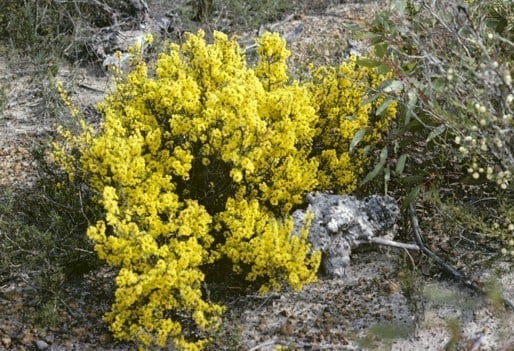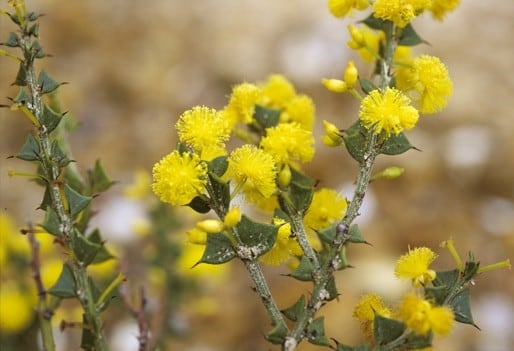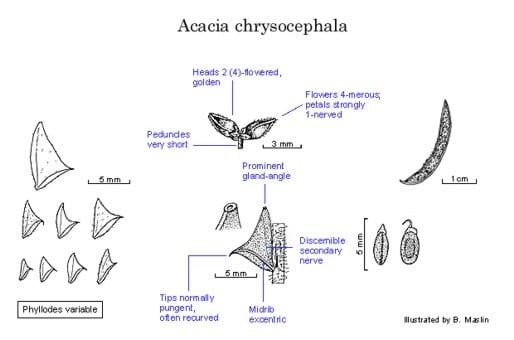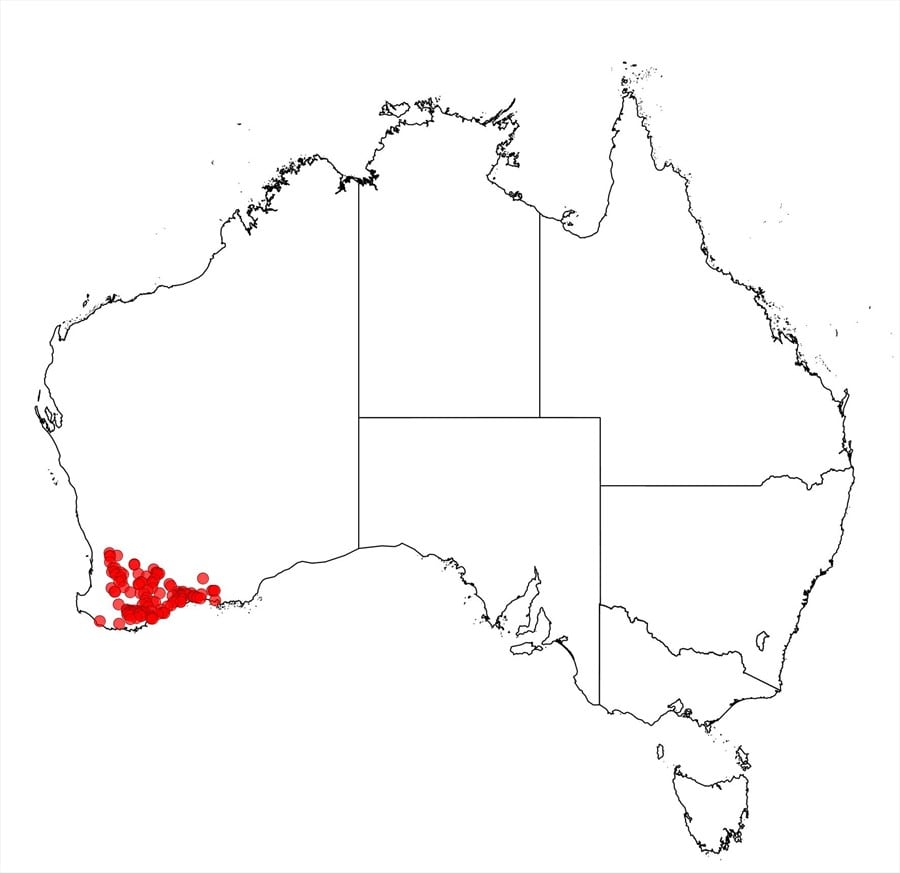Acacia chrysocephala Maslin
WATTLE
Acacias of Australia
Family
Fabaceae
Distribution
Scattered from York S to the Stirling Ra. area and E to near Bremer Bay and Scaddan, south-western W.A.
Description
Compact subshrub 0.3–0.5 m high. Branchlets ribbed, sparsely to moderately puberulous, shortly pilose or strigulose, with hairs patent or appressed. Phyllodes inequilateral, obtriangular to shallowly obtriangular with a prominent gland-bearing angle on adaxial margin, obliquely truncate, with adaxial proximal margin ±congruent with branchlet, 3–12 mm long, 1.5–10 mm wide, commonly pungent, glabrous or sparsely puberulous; midrib near abaxial margin, with a minor nerve extending from base towards the gland. Inflorescences simple, commonly 1 per axil; peduncles 0.5–3 (–5) mm long, glabrous or subglabrous; heads globular, 2–4-flowered, golden; buds acute. Flowers 4-merous; sepals 1/2–3/4-united, with ±triangular lobes; petals prominently 1-nerved at apex. Pods shallowly curved, to c. 3 cm long, 2–3 mm wide, coriaceous-crustaceous, glabrous or hairy; margins thick. Seeds longitudinal, ±oblong, 2.5–3 mm long, shiny, brown or grey-brown, arillate.
Habitat
Grows mainly in sand over laterite or clay; in the W of its range it occurs in Wandoo (Eucalyptus wandoo) woodland and Jarrah (E. marginata) forest and in the E in mallee scrub and shrubland or rarely in low heath.
Specimens
W.A.: Wambyn Nature Reserve, 13 km W of York, G.J.Keighery & J.J.Alford 14 (PERTH); Stirling Ra., Red Gum Pass, B.R.Maslin 4006 (PERTH); Munglinup area E of Ravensthorpe, B.R.Maslin 4481 (CANB, K, MEL, PERTH); 21 km E of Nyabing on the road to Pingrup, B.R.Maslin 6347 (PERTH, Z).
Notes
A variable species, especially with respect to branchlet indumentum and phyllode morphology. Four main variants are recognised and future studies may show that these should be afforded formal rank.
Distinguished from other members of the ‘A. biflora group’ by a combination of the following characters: heads golden and 2–4-flowered, peduncles 0.5–3 (–5) mm long, petals prominently 1-nerved. Perhaps related to A. incrassata which has more numerous-flowered heads (normally 6–9-flowered) and longer peduncles (4–8 mm long).
The two remaining variants have inflorescences with heads that are 3- or 4-flowered. The third variant has branchlet hairs retrorse, rarely patent; phyllodes 4–10 mm wide, mucro straight. It occurs in the York–Wagin area. The fourth variant has branchlet hairs antrorse; phyllodes 4–6 mm wide, mucro shallowly recurved. It occurs in the Hyden–Jerramungup area.
Two of the four variants have inflorescences with heads that are 2-flowered. The typical variant has branchlet hairs patent to retrorse; phyllodes mostly 1.5–4 mm wide, mucro c. 0.5 mm long and scarcely pungent; heads 2-flowered; pods hairy. It occurs in the Stirling Ra. area. The second variant has branchlet hairs antrorse, rarely patent; phyllodes mostly 4–10 mm wide, mucro 0.5–1.5 mm long and distinctly pungent; heads 2-flowered; pods glabrous. It occurs in the Ongerup–Bremer Bay–Scaddan area.
FOA Reference
Data derived from Flora of Australia Volumes 11A (2001), 11B (2001) and 12 (1998), products of ABRS, ©Commonwealth of Australia
Author
B.R.Maslin
Minor edits by J.Rogers
This identification key and fact sheets are available as a mobile application:
URL: https://apps.lucidcentral.org/wattle/
© Copyright 2018. All rights reserved.










